Infrared Spectroscopy–Quo Vadis?
Abstract
1. Introduction
2. Infrared Spectroscopy: The Past
3. Infrared Spectroscopy: The Present
4. Infrared Spectroscopy: The Future
5. Conclusions
Author Contributions
Funding
Acknowledgments
Conflicts of Interest
Dedication
References
- Griffiths, P.R.; de Haseth, J.A. Fourier Transform Infrared Spectrometry; Wiley-Interscience: Hoboken, NJ, USA, 2007; ISBN 9780471194040. [Google Scholar]
- Haas, J.; Mizaikoff, B. Advances in Mid-Infrared Spectroscopy for Chemical Analysis. Annu. Rev. Anal. Chem. 2016, 9, 45–68. [Google Scholar] [CrossRef] [PubMed]
- Müller, C.M.; Molinelli, A.; Karlowatz, M.; Aleksandrov, A.; Orlando, T.; Mizaikoff, B. Infrared Attenuated Total Reflection Spectroscopy of Quartz and Silica Micro- and Nanoparticulate Films. J. Phys. Chem. C 2012, 116, 37–43. [Google Scholar] [CrossRef]
- Karn, A.; Heim, C.; Flint-Garcia, S.; Bilyeu, K.; Gillman, J. Development of Rigorous Fatty Acid Near-Infrared Spectroscopy Quantitation Methods in Support of Soybean Oil Improvement. J. Am. Oil Chem. Soc. 2017, 94, 69–76. [Google Scholar] [CrossRef]
- van den Broek, W.H.A.M.; Derks, E.P.P.A.; van de Ven, E.W.; Wienke, D.; Geladi, P.; Buydens, L.M.C. Plastic Identification by Remote Sensing Spectroscopic NIR Imaging Using Kernel Partial Least Squares (KPLS). Chemom. Intell. Lab. Syst. 1996, 35, 187–197. [Google Scholar] [CrossRef][Green Version]
- Wilks, P. NIR vs. Mid-IR-How to Choose. Spectroscopy 2006, 21, 43–46. [Google Scholar]
- Kim, S.-S.; Young, C.; Mizaikoff, B. Miniaturized Mid-Infrared Sensor Technologies. Anal. Bioanal. Chem. 2008, 390, 231–237. [Google Scholar] [CrossRef]
- McMullin, D.; Mizaikoff, B.; Krska, R. Advancements in IR Spectroscopic Approaches for the Determination of Fungal Derived Contaminations in Food Crops. Anal. Bioanal. Chem. 2015, 407, 653–660. [Google Scholar] [CrossRef]
- Nikolaou, A.D.; Golfinopoulos, S.K.; Kostopoulou, M.N.; Kolokythas, G.A.; Lekkas, T.D. Determination of Volatile Organic Compounds in Surface Waters and Treated Wastewater in Greece. Water Res. 2002, 36, 2883–2890. [Google Scholar] [CrossRef]
- Klein, O.; Roth, A.; Dornuf, F.; Schöller, O.; Mäntele, W. The Good Vibrations of Beer. The Use of Infrared and UV/Vis Spectroscopy and Chemometry for the Quantitative Analysis of Beverages. Z. Nat. B 2012, 67, 1005–1015. [Google Scholar] [CrossRef]
- Culbert, J.; Cozzolino, D.; Ristic, R.; Wilkinson, K. Classification of Sparkling Wine Style and Quality by MIR Spectroscopy. Molecules 2015, 20, 8341–8356. [Google Scholar] [CrossRef]
- Kumar, K.; Giehl, A.; Schweiggert, R.; Patz, C.-D. Multidimensional Scaling Assisted Fourier-Transform Infrared Spectroscopic Analysis of Fruit Wine Samples: Introducing a Novel Analytical Approach. Anal. Methods 2019, 11, 4106–4115. [Google Scholar] [CrossRef]
- Daffara, C.; Pampaloni, E.; Pezzati, L.; Barucci, M.; Fontana, R. Scanning Multispectral IR Reflectography SMIRR: An Advanced Tool for Art Diagnostics. Acc. Chem. Res. 2010, 43, 847–856. [Google Scholar] [CrossRef]
- Umeno, M.; Yoshimoto, M.; Shimizu, H.; Amemiya, Y. Ellipsometric and Infrared Spectroscopic Studies of Oxide Film on GaAs Surface. Surf. Sci. 1979, 86, 314–321. [Google Scholar] [CrossRef]
- Taghavi, S.; Ayatollahi, S.; Alibolandi, M.; Lavaee, P.; Ramezani, M.; Abnous, K. A Novel Label Free Cocaine Assay Based on Aptamer-Wrapped Single-Walled Carbon Nanotubes. Nanomed. J. 2014, 1, 100–106. [Google Scholar]
- da Silva, V.H.; da Silva, J.J.; Pereira, C.F. Portable Near-Infrared Instruments: Application for Quality Control of Polymorphs in Pharmaceutical Raw Materials and Calibration Transfer. J. Pharm. Biomed. Anal. 2017, 134, 287–294. [Google Scholar] [CrossRef]
- Stach, R.; Mizaikoff, B. Fuel Performance Specifications, Mid-Infrared Analysis Of. In Encyclopedia of Anal. Chem.; John Wiley & Sons, Ltd.: Chichester, UK, 2017; pp. 1–16. [Google Scholar]
- Razeghi, M.; Lu, Q.Y.; Bandyopadhyay, N.; Zhou, W.; Heydari, D.; Bai, Y.; Slivken, S. Quantum Cascade Lasers: From Tool to Product. Opt. Express 2015, 23, 8462. [Google Scholar] [CrossRef]
- Malyutenko, V.; Zinovchuk, A. Midinfrared LEDs Versus Thermal Emitters in IR Dynamic Scene Simulation Devices; Proc. SPIE 6368, Optoelectronic Devices: Physics, Fabrication, and Application III, 63680D; SPIE: Boston, MA, USA, 2006. [Google Scholar]
- Hlavatsch, M.; Mizaikoff, B. Advanced Mid-Infrared Lightsources above and beyond Lasers and Their Analytical Utility. Anal. Sci. 2022, 1–15. [Google Scholar] [CrossRef] [PubMed]
- Wolffenbuttel, R.F. MEMS-Based Optical Mini- and Microspectrometers for the Visible and Infrared Spectral Range. J. Micromech. Microeng. 2005, 15, S145–S152. [Google Scholar] [CrossRef]
- Vurgaftman, I.; Weih, R.; Kamp, M.; Meyer, J.R.; Canedy, C.L.; Kim, C.S.; Kim, M.; Bewley, W.W.; Merritt, C.D.; Abell, J.; et al. Interband Cascade Lasers. J. Phys. D Appl. Phys. 2015, 48, 123001. [Google Scholar] [CrossRef]
- Brandstetter, M.; Lendl, B. Tunable Mid-Infrared Lasers in Physical Chemosensors towards the Detection of Physiologically Relevant Parameters in Biofluids. Sens. Actuators B Chem. 2012, 170, 189–195. [Google Scholar] [CrossRef]
- Childs, D.T.D.; Hogg, R.A.; Revin, D.G.; Rehman, I.U.; Cockburn, J.W.; Matcher, S.J. Sensitivity Advantage of QCL Tunable-Laser Mid-Infrared Spectroscopy Over FTIR Spectroscopy. Appl. Spectrosc. Rev. 2015, 50, 822–839. [Google Scholar] [CrossRef]
- Jaeschke, C.; Glöckler, J.; El Azizi, O.; Gonzalez, O.; Padilla, M.; Mitrovics, J.; Mizaikoff, B. An Innovative Modular ENose System Based on a Unique Combination of Analog and Digital Metal Oxide Sensors. ACS Sens. 2019, 4, 2277–2281. [Google Scholar] [CrossRef] [PubMed]
- De, A.; Banik, G.D.; Maity, A.; Pal, M.; Pradhan, M. Continuous Wave External-Cavity Quantum Cascade Laser-Based High-Resolution Cavity Ring-down Spectrometer for Ultrasensitive Trace Gas Detection. Opt. Lett. 2016, 41, 1949. [Google Scholar] [CrossRef]
- José Gomes da Silva, I.; Tütüncü, E.; Nägele, M.; Fuchs, P.; Fischer, M.; Raimundo, I.M.; Mizaikoff, B. Sensing Hydrocarbons with Interband Cascade Lasers and Substrate-Integrated Hollow Waveguides. Analyst 2016, 141, 4432–4437. [Google Scholar] [CrossRef] [PubMed]
- Haas, J.; Catalán, E.V.; Piron, P.; Karlsson, M.; Mizaikoff, B. Infrared Spectroscopy Based on Broadly Tunable Quantum Cascade Lasers and Polycrystalline Diamond Waveguides. Analyst 2018, 143, 5112–5119. [Google Scholar] [CrossRef]
- Kosterev, A.; Wysocki, G.; Bakhirkin, Y.; So, S.; Lewicki, R.; Fraser, M.; Tittel, F.; Curl, R.F. Application of Quantum Cascade Lasers to Trace Gas Analysis. Appl. Phys. B 2008, 90, 165–176. [Google Scholar] [CrossRef]
- Banik, G.D.; Som, S.; Maity, A.; Pal, M.; Maithani, S.; Mandal, S.; Pradhan, M. An EC-QCL Based N 2 O Sensor at 5.2 Μm Using Cavity Ring-down Spectroscopy for Environmental Applications. Anal. Methods 2017, 9, 2315–2320. [Google Scholar] [CrossRef]
- Stach, R.; Haas, J.; Tütüncü, E.; Daboss, S.; Kranz, C.; Mizaikoff, B. PolyHWG: 3D Printed Substrate-Integrated Hollow Waveguides for Mid-Infrared Gas Sensing. ACS Sens. 2017, 2, 1700–1705. [Google Scholar] [CrossRef]
- Liu, Z.; Zheng, C.; Zhang, T.; Li, Y.; Ren, Q.; Chen, C.; Ye, W.; Zhang, Y.; Wang, Y.; Tittel, F.K. Midinfrared Sensor System Based on Tunable Laser Absorption Spectroscopy for Dissolved Carbon Dioxide Analysis in the South China Sea: System-Level Integration and Deployment. Anal. Chem. 2020, 92, 8178–8185. [Google Scholar] [CrossRef]
- Dong, L.; Li, C.; Sanchez, N.P.; Gluszek, A.K.; Griffin, R.J.; Tittel, F.K. Compact CH4 Sensor System Based on a Continuous-Wave, Low Power Consumption, Room Temperature Interband Cascade Laser. Appl. Phys. Lett. 2016, 108, 011106. [Google Scholar] [CrossRef]
- Alcaráz, M.R.; Schwaighofer, A.; Kristament, C.; Ramer, G.; Brandstetter, M.; Goicoechea, H.; Lendl, B. External-Cavity Quantum Cascade Laser Spectroscopy for Mid-IR Transmission Measurements of Proteins in Aqueous Solution. Anal. Chem. 2015, 87, 6980–6987. [Google Scholar] [CrossRef]
- Tütüncü, E.; Kokoric, V.; Szedlak, R.; MacFarland, D.; Zederbauer, T.; Detz, H.; Andrews, A.M.; Schrenk, W.; Strasser, G.; Mizaikoff, B. Advanced Gas Sensors Based on Substrate-Integrated Hollow Waveguides and Dual-Color Ring Quantum Cascade Lasers. Analyst 2016, 141, 6202–6207. [Google Scholar] [CrossRef]
- Szedlak, R.; Harrer, A.; Holzbauer, M.; Schwarz, B.; Waclawek, J.P.; MacFarland, D.; Zederbauer, T.; Detz, H.; Andrews, A.M.; Schrenk, W.; et al. Remote Sensing with Commutable Monolithic Laser and Detector. ACS Photonics 2016, 3, 1794–1798. [Google Scholar] [CrossRef]
- Perez-Guaita, D.; Kokoric, V.; Wilk, A.; Garrigues, S.; Mizaikoff, B. Towards the Determination of Isoprene in Human Breath Using Substrate-Integrated Hollow Waveguide Mid-Infrared Sensors. J. Breath Res. 2014, 8, 026003. [Google Scholar] [CrossRef] [PubMed]
- Wilk, A.; Carter, J.C.; Chrisp, M.; Manuel, A.M.; Mirkarimi, P.; Alameda, J.B.; Mizaikoff, B. Substrate-Integrated Hollow Waveguides: A New Level of Integration in Mid-Infrared Gas Sensing. Anal. Chem. 2013, 85, 11205–11210. [Google Scholar] [CrossRef] [PubMed]
- Seichter, F.; Tütüncü, E.; Hagemann, L.T.; Vogt, J.; Wachter, U.; Gröger, M.; Kress, S.; Radermacher, P.; Mizaikoff, B. Online Monitoring of Carbon Dioxide and Oxygen in Exhaled Mouse Breath via Substrate-Integrated Hollow Waveguide Fourier-Transform Infrared-Luminescence Spectroscopy. J. Breath Res. 2018, 12, 036018. [Google Scholar] [CrossRef] [PubMed]
- Mersen Boostec® Silicon Carbide SiC. Available online: https://www.mersen.com/products/graphite-specialties/boostec-silicon-carbide-sic (accessed on 1 July 2021).
- European Southern Observatory Extremely Large Telescope. Available online: https://elt.eso.org/ (accessed on 1 July 2021).
- Bougoin, M.; Lavenac, J.; Gerbert-Gaillard, A.; Pierot, D. The SiC Primary Mirror of the EUCLID Telescope. In Proceedings of the International Conference on Space Optics—ICSO 2016, Biarritz, France, 18–21 October 2016; Karafolas, N., Cugny, B., Sodnik, Z., Eds.; SPIE: Bellingham, WA, USA, 2017; p. 48. [Google Scholar]
- Haas, J.; Pleyer, M.; Nauschütz, J.; Koeth, J.; Nägele, M.; Bibikova, O.; Sakharova, T.; Artyushenko, V.; Mizaikoff, B. IBEAM: Substrate-Integrated Hollow Waveguides for Efficient Laser Beam Combining. Opt. Express 2019, 27, 23059. [Google Scholar] [CrossRef] [PubMed]
- Pyreos Ltd. Thin Film Pyroelectric IR Line Sensor Array Demonstrator Kit; Pyreos Ltd.: Edinburgh, UK, 2009; Available online: https://pyreos.com/evaluation-kits/ (accessed on 26 June 2021).
- Kim, H.; Lee, J.H.; Lee, J.I.; Ko, S.Y.; Choi, Y.G. Compositional Dependence of Infrared Transmission in Ge-Based Chalcogenide Glasses. Phys. Status Solidi B 2020, 257, 2000164. [Google Scholar] [CrossRef]
- Schott AG IRG Chalcogenide Glasses. Available online: https://www.schott.com/en-gb/products/ir-materials-p1000261/product-variants?tab=ir-materials-irg-chalcogenide-glasses-irg-22-27 (accessed on 22 July 2022).
- Kraft, M.; Jakusch, M.; Karlowatz, M.; Katzir, A.; Mizaikoff, B. New Frontiers for Mid-Infrared Sensors: Towards Deep Sea Monitoring with a Submarine FT-IR Sensor System. Appl. Spectrosc. 2003, 57, 591–599. [Google Scholar] [CrossRef] [PubMed]
- Rauh, F.; Luzinova, Y.; Katzir, A.; Pfeiffer, J.; Mizaikoff, B. A Gas Hydrate Autoclave Suitable for In-Situ Fiber Optic Infrared Spectroscopic Studies. In Proceedings of the 7th International Conference on Gas Hydrates, Edinburgh, UK, 17–21 July 2011. [Google Scholar]
- Schädle, T.; Eifert, A.; Kranz, C.; Raichlin, Y.; Katzir, A.; Mizaikoff, B. Mid-Infrared Planar Silver Halide Waveguides with Integrated Grating Couplers. Appl. Spectrosc. 2013, 67, 1057–1063. [Google Scholar] [CrossRef] [PubMed]
- Dettenrieder, C.; Raichlin, Y.; Katzir, A.; Mizaikoff, B. Toward the Required Detection Limits for Volatile Organic Constituents in Marine Environments with Infrared Evanescent Field Chemical Sensors. Sensors 2019, 19, 3644. [Google Scholar] [CrossRef]
- Wang, X.; Kim, S.-S.; Roßbach, R.; Jetter, M.; Michler, P.; Mizaikoff, B. Ultra-Sensitive Mid-Infrared Evanescent Field Sensors Combining Thin-Film Strip Waveguides with Quantum Cascade Lasers. Analyst 2012, 137, 2322. [Google Scholar] [CrossRef] [PubMed]
- Sieger, M.; Haas, J.; Jetter, M.; Michler, P.; Godejohann, M.; Mizaikoff, B. Mid-Infrared Spectroscopy Platform Based on GaAs/AlGaAs Thin-Film Waveguides and Quantum Cascade Lasers. Anal. Chem. 2016, 88, 2558–2562. [Google Scholar] [CrossRef] [PubMed]
- Churbanov, M.F.; Denker, B.I.; Galagan, B.I.; Koltashev, V.V.; Plotnichenko, V.G.; Sukhanov, M.V.; Sverchkov, S.E.; Velmuzhov, A.P. First Demonstration of ~ 5 µm Laser Action in Terbium-Doped Selenide Glass. Appl. Phys. B 2020, 126, 117. [Google Scholar] [CrossRef]
- Denker, B.I.; Galagan, B.I.; Koltashev, V.V.; Plotnichenko, V.G.; Snopatin, G.E.; Sukhanov, M.V.; Sverchkov, S.E.; Velmuzhov, A.P. Continuous Tb-Doped Fiber Laser Emitting at ∼5.25 µm. Opt. Laser Technol. 2022, 154, 108355. [Google Scholar] [CrossRef]
- Haas, J.; Catalán, E.V.; Piron, P.; Nikolajeff, F.; Österlund, L.; Karlsson, M.; Mizaikoff, B. Polycrystalline Diamond Thin-Film Waveguides for Mid-Infrared Evanescent Field Sensors. ACS Omega 2018, 3, 6190–6198. [Google Scholar] [CrossRef]
- Diamond Materials Diamond Crystals. Available online: https://www.diamond-materials.com/en/ (accessed on 15 September 2021).
- López-Lorente, Á.I.; Wang, P.; Sieger, M.; Vargas Catalan, E.; Karlsson, M.; Nikolajeff, F.; Österlund, L.; Mizaikoff, B. Mid-Infrared Thin-Film Diamond Waveguides Combined with Tunable Quantum Cascade Lasers for Analyzing the Secondary Structure of Proteins. Phys. Status Solidi A 2016, 213, 2117–2123. [Google Scholar] [CrossRef]
- Wang, X.; Karlsson, M.; Forsberg, P.; Sieger, M.; Nikolajeff, F.; Österlund, L.; Mizaikoff, B. Diamonds Are a Spectroscopist’s Best Friend: Thin-Film Diamond Mid-Infrared Waveguides for Advanced Chemical Sensors/Biosensors. Anal. Chem. 2014, 86, 8136–8141. [Google Scholar] [CrossRef] [PubMed]
- Dobbs, G.T.; Balu, B.; Young, C.; Kranz, C.; Hess, D.W.; Mizaikoff, B. Mid-Infrared Chemical Sensors Utilizing Plasma-Deposited Fluorocarbon Membranes. Anal. Chem. 2007, 79, 9566–9571. [Google Scholar] [CrossRef]
- Nedeljkovic, M.; Khokhar, A.Z.; Hu, Y.; Chen, X.; Penades, J.S.; Stankovic, S.; Chong, H.M.H.; Thomson, D.J.; Gardes, F.Y.; Reed, G.T.; et al. Silicon Photonic Devices and Platforms for the Mid-Infrared. Opt. Mater. Express 2013, 3, 1205. [Google Scholar] [CrossRef]
- El Shamy, R.S.; Mossad, H.; Swillam, M.A. Long-Range All-Dielectric Plasmonic Waveguide in Mid-Infrared. Appl. Phys. A 2017, 123, 52. [Google Scholar] [CrossRef]
- Zinoviev, K.E.; Gonzalez-Guerrero, A.B.; Dominguez, C.; Lechuga, L.M. Integrated Bimodal Waveguide Interferometric Biosensor for Label-Free Analysis. J. Lightwave Technol. 2011, 29, 1926–1930. [Google Scholar] [CrossRef]
- Lechuga, L.M.; Sepulveda, B.; Sanchez del Rio, J.; Blanco, F.; Calle, A.; Dominguez, C. Integrated Micro- and Nano-Optical Biosensor Silicon Devices CMOS Compatible. In Optoelectronic Integration on Silicon; Robbins, D.J., Jabbour, G.E., Eds.; SPIE: New York, NY, USA, 2004; pp. 96–110. [Google Scholar]
- Sieger, M.; Balluff, F.; Wang, X.; Kim, S.-S.; Leidner, L.; Gauglitz, G.; Mizaikoff, B. On-Chip Integrated Mid-Infrared GaAs/AlGaAs Mach–Zehnder Interferometer. Anal. Chem. 2013, 85, 3050–3052. [Google Scholar] [CrossRef] [PubMed]
- Haas, J.; Artmann, P.; Mizaikoff, B. Mid-Infrared GaAs/AlGaAs Micro-Ring Resonators Characterized via Thermal Tuning. RSC Adv. 2019, 9, 8594–8599. [Google Scholar] [CrossRef] [PubMed]
- Blanco, F.J.; Agirregabiria, M.; Berganzo, J.; Mayora, K.; Elizalde, J.; Calle, A.; Dominguez, C.; Lechuga, L.M. Microfluidic-Optical Integrated CMOS Compatible Devices for Label-Free Biochemical Sensing. J. Micromech. Microeng. 2006, 16, 1006–1016. [Google Scholar] [CrossRef]
- Doradla, P.; Joseph, C.S.; Kumar, J.; Giles, R.H. Characterization of Bending Loss in Hollow Flexible Terahertz Waveguides. Opt. Express 2012, 20, 19176. [Google Scholar] [CrossRef]
- Abel, T.; Hirsch, J.; Harrington, J.A. Hollow Glass Waveguides for Broadband Infrared Transmission. Opt. Lett. 1994, 19, 1034. [Google Scholar] [CrossRef]
- Harrington, J.A.; Hirsch, J.; Abel, T.; Matsuura, Y. Small-Bore Hollow Waveguide for Delivery of near Singlemode IR Laser Radiation. Electron. Lett. 1994, 30, 1688–1690. [Google Scholar] [CrossRef]
- Wang, P.; Balko, J.; Lu, R.; López-Lorente, Á.I.; Dürselen, L.; Mizaikoff, B. Analysis of Human Menisci Degeneration via Infrared Attenuated Total Reflection Spectroscopy. Analyst 2018, 143, 5023–5029. [Google Scholar] [CrossRef]
- Töyräs, J.; Lyyra-Laitinen, T.; Niinimäki, M.; Lindgren, R.; Nieminen, M.T.; Kiviranta, I.; Jurvelin, J.S. Estimation of the Young’s Modulus of Articular Cartilage Using an Arthroscopic Indentation Instrument and Ultrasonic Measurement of Tissue Thickness. J. Biomech. 2001, 34, 251–256. [Google Scholar] [CrossRef]
- Mao, Z.-H.; Yin, J.-H.; Zhang, X.-X.; Wang, X.; Xia, Y. Discrimination of Healthy and Osteoarthritic Articular Cartilage by Fourier Transform Infrared Imaging and Fisher’s Discriminant Analysis. Biomedical Opt. Express 2016, 7, 448. [Google Scholar] [CrossRef]
- Rieppo, L.; Töyräs, J.; Saarakkala, S. Vibrational Spectroscopy of Articular Cartilage. Appl. Spectrosc. Rev. 2017, 52, 249–266. [Google Scholar] [CrossRef]
- Pleitez, M.; von Lilienfeld-Toal, H.; Mäntele, W. Infrared Spectroscopic Analysis of Human Interstitial Fluid in Vitro and in Vivo Using FT-IR Spectroscopy and Pulsed Quantum Cascade Lasers (QCL): Establishing a New Approach to Non Invasive Glucose Measurement. Spectrochim. Acta Part A Mol. Biomol. Spectrosc. 2012, 85, 61–65. [Google Scholar] [CrossRef]
- Mohar, B. Real-Time Mid-IR Chemical Imaging of Dynamic Processes: Proton-Deuteron Exchange within a Micro Fluidic System Using the Spero TM QCL Based Microscope. Daylight Solut. 2015. Available online: https://daylightsolutions.com/wp-content/uploads/2017/09/Spero-AN201501-Real-Time-Chemical-Imaging-of-Microfluidic-System.pdf (accessed on 26 June 2021).
- Beć, K.B.; Grabska, J.; Huck, C.W. Biomolecular and Bioanalytical Applications of Infrared Spectroscopy–A Review. Anal. Chim. Acta 2020, 1133, 150–177. [Google Scholar] [CrossRef] [PubMed]
- Findlay, C.R.; Wiens, R.; Rak, M.; Sedlmair, J.; Hirschmugl, C.J.; Morrison, J.; Mundy, C.J.; Kansiz, M.; Gough, K.M. Rapid Biodiagnostic Ex Vivo Imaging at 1 Μm Pixel Resolution with Thermal Source FTIR FPA. Analyst 2015, 140, 2493–2503. [Google Scholar] [CrossRef]
- Wrobel, T.P.; Marzec, K.M.; Majzner, K.; Kochan, K.; Bartus, M.; Chlopicki, S.; Baranska, M. Attenuated Total Reflection Fourier Transform Infrared (ATR-FTIR) Spectroscopy of a Single Endothelial Cell. Analyst 2012, 137, 4135. [Google Scholar] [CrossRef]
- Chan, K.L.A.; Altharawi, A.; Fale, P.; Song, C.L.; Kazarian, S.G.; Cinque, G.; Untereiner, V.; Sockalingum, G.D. Transmission Fourier Transform Infrared Spectroscopic Imaging, Mapping, and Synchrotron Scanning Microscopy with Zinc Sulfide Hemispheres on Living Mammalian Cells at Sub-Cellular Resolution. Appl. Spectrosc. 2020, 74, 544–552. [Google Scholar] [CrossRef] [PubMed]
- Chan, K.L.A.; Kazarian, S.G. Attenuated Total Reflection Fourier-Transform Infrared (ATR-FTIR) Imaging of Tissues and Live Cells. Chem. Soc. Rev. 2016, 45, 1850–1864. [Google Scholar] [CrossRef]
- Chan, K.L.A.; Kazarian, S.G. Correcting the Effect of Refraction and Dispersion of Light in FT-IR Spectroscopic Imaging in Transmission through Thick Infrared Windows. Anal. Chem. 2013, 85, 1029–1036. [Google Scholar] [CrossRef]
- Finlayson, D.; Rinaldi, C.; Baker, M.J. Is Infrared Spectroscopy Ready for the Clinic? Anal. Chem. 2019, 91, 12117–12128. [Google Scholar] [CrossRef]
- Banas, A.; Banas, K.; Lo, M.K.F.; Kansiz, M.; Kalaiselvi, S.M.P.; Lim, S.K.; Loke, J.; Breese, M.B.H. Detection of High-Explosive Materials within Fingerprints by Means of Optical-Photothermal Infrared Spectromicroscopy. Anal. Chem. 2020, 92, 9649–9657. [Google Scholar] [CrossRef]
- Photothermal Spectroscopy Corp Optical Photothermal Infrared (O-PTIR) Spectroscopy. Available online: https://www.photothermal.com/mirage/ (accessed on 6 August 2021).
- Ouyang, T.; Wang, C.; Yu, Z.; Stach, R.; Mizaikoff, B.; Huang, G.-B.; Wang, Q.-J. NOx Measurements in Vehicle Exhaust Using Advanced Deep ELM Networks. IEEE Trans. Instrum. Meas. 2021, 70, 1–10. [Google Scholar] [CrossRef]
- Ouyang, T.; Wang, C.; Yu, Z.; Stach, R.; Mizaikoff, B.; Liedberg, B.; Huang, G.-B.; Wang, Q.-J. Quantitative Analysis of Gas Phase IR Spectra Based on Extreme Learning Machine Regression Model. Sensors 2019, 19, 5535. [Google Scholar] [CrossRef] [PubMed]
- Öner, T.; Thiam, P.; Kos, G.; Krska, R.; Schwenker, F.; Mizaikoff, B. Machine Learning Algorithms for the Automated Classification of Contaminated Maize at Regulatory Limits via Infrared Attenuated Total Reflection Spectroscopy. World Mycotoxin J. 2019, 12, 113–122. [Google Scholar] [CrossRef]
- Sieger, M.; Kos, M.; Sulyok, M.; Godejohann, M.; Krsha, R.; Mizaikoff, B. Mid-Infrared Spectroscopy Based on GaAs Thin-Film Waveguide and Quantum Cascade Laser Technology as a Tool for the Detection of Deoxynivalenol (DON) in Maize Extracts. In Proceedings of the 8th Conference on World Mycotoxin Forum, Martina Franca, Italy, 27–31 May 2013; p. 314018. [Google Scholar]
- Sieger, M.; Kos, G.; Sulyok, M.; Godejohann, M.; Krska, R.; Mizaikoff, B. Portable Infrared Laser Spectroscopy for On-Site Mycotoxin Analysis. Sci. Rep. 2017, 7, 44028. [Google Scholar] [CrossRef] [PubMed]
- Knittel, P.; Stach, R.; Yoshikawa, T.; Kirste, L.; Mizaikoff, B.; Kranz, C.; Nebel, C.E. Characterisation of Thin Boron-Doped Diamond Films Using Raman Spectroscopy and Chemometrics. Anal. Methods 2019, 11, 582–586. [Google Scholar] [CrossRef]
- da Silva Oliveira, V.; Honorato, R.S.; Honorato, F.A.; Pereira, C.F. Authenticity Assessment of Banknotes Using Portable near Infrared Spectrometer and Chemometrics. Forensic Sci. Int. 2018, 286, 121–127. [Google Scholar] [CrossRef]
- Vasilikos, I.; Haas, J.; Teixeira, G.Q.; Nothelfer, J.; Neidlinger-Wilke, C.; Wilke, H.; Seitz, A.; Vavvas, D.G.; Zentner, J.; Beck, J.; et al. Infrared Attenuated Total Reflection Spectroscopic Surface Analysis of Bovine-tail Intervertebral Discs after UV-light-activated Riboflavin-induced Collagen Cross-linking. J. Biophotonics 2020, 13. [Google Scholar] [CrossRef]
- Kos, G.; Sieger, M.; McMullin, D.; Zahradnik, C.; Sulyok, M.; Öner, T.; Mizaikoff, B.; Krska, R. A Novel Chemometric Classification for FTIR Spectra of Mycotoxin-Contaminated Maize and Peanuts at Regulatory Limits. Food Addit. Contam. Part A 2016, 33, 1596–1607. [Google Scholar] [CrossRef] [PubMed]
- Stach, R.; Pejcic, B.; Crooke, E.; Myers, M.; Mizaikoff, B. Mid-Infrared Spectroscopic Method for the Identification and Quantification of Dissolved Oil Components in Marine Environments. Anal. Chem. 2015, 87, 12306–12312. [Google Scholar] [CrossRef] [PubMed]
- Wahr, J.A.; Tremper, K.K.; Samra, S.; Delpy, D.T. Near-Infrared Spectroscopy: Theory and Applications. J. Cardiothorac. Vasc. Anesth. 1996, 10, 406–418. [Google Scholar] [CrossRef]
- Wolf, M.; Ferrari, M.; Quaresima, V. Progress of Near-Infrared Spectroscopy and Topography for Brain and Muscle Clinical Applications. J Biomed. Opt. 2007, 12, 062104. [Google Scholar] [CrossRef]
- Muehlemann, T.; Haensse, D.; Wolf, M. Wireless Miniaturized In-Vivo near Infrared Imaging. Opt. Express 2008, 16, 10323. [Google Scholar] [CrossRef] [PubMed]
- Lee, H.; Ko, H.; Lee, J. Reflectance Pulse Oximetry: Practical Issues and Limitations. ICT Express 2016, 2, 195–198. [Google Scholar] [CrossRef]
- Zhang, X.; Jing, Y.; Zhai, Q.; Yu, Y.; Xing, H.; Li, J.; Wang, E. Point-of-Care Diagnoses: Flexible Patterning Technique for Self-Powered Wearable Sensors. Anal. Chem. 2018, 90, 11780–11784. [Google Scholar] [CrossRef] [PubMed]
- Camacho, N.P.; West, P.; Torzilli, P.A.; Mendelsohn, R. FTIR Microscopic Imaging of Collagen and Proteoglycan in Bovine Cartilage. Biopolymers 2001, 62, 1–8. [Google Scholar] [CrossRef]
- Weida, M.J.; Yee, B. Quantum Cascade Laser-Based Replacement for FTIR Microscopy. In Imaging, Manipulation, and Analysis of Biomolecules, Cells, and Tissues IX; Farkas, D.L., Nicolau, D.V., Leif, R.C., Eds.; SPIE: Bellingham, WA, USA, 2011; p. 79021C. [Google Scholar]
- Cagnoni, S.; Cozzini, L.; Lombardo, G.; Mordonini, M.; Poggi, A.; Tomaiuolo, M. Emotion-Based Analysis of Programming Languages on Stack Overflow. ICT Express 2020, 6, 238–242. [Google Scholar] [CrossRef]
- Jarvis, R.M.; Broadhurst, D.; Johnson, H.; O’Boyle, N.M.; Goodacre, R. PYCHEM: A Multivariate Analysis Package for Python. Bioinformatics 2006, 22, 2565–2566. [Google Scholar] [CrossRef] [PubMed]
- Osorio, J.D.; Vilches, S.; Zappe, H. Diffuse Reflectance Spectroscopy as a Monitoring Tool for Gastric Mucosal Devitalization Treatments with Argon Plasma Coagulation. J. Biophotonics 2020, 13, e201960125. [Google Scholar] [CrossRef] [PubMed]
- Heraud, P.; Chatchawal, P.; Wongwattanakul, M.; Tippayawat, P.; Doerig, C.; Jearanaikoon, P.; Perez-Guaita, D.; Wood, B.R. Infrared Spectroscopy Coupled to Cloud-Based Data Management as a Tool to Diagnose Malaria: A Pilot Study in a Malaria-Endemic Country. Malar. J. 2019, 18, 348. [Google Scholar] [CrossRef] [PubMed]
- Käppler, A.; Windrich, F.; Löder, M.G.J.; Malanin, M.; Fischer, D.; Labrenz, M.; Eichhorn, K.-J.; Voit, B. Identification of Microplastics by FTIR and Raman Microscopy: A Novel Silicon Filter Substrate Opens the Important Spectral Range below 1300 cm−1 for FTIR Transmission Measurements. Anal. Bioanal. Chem. 2015, 407, 6791–6801. [Google Scholar] [CrossRef]
- Schädle, T.; Pejcic, B.; Myers, M.; Mizaikoff, B. Fingerprinting Oils in Water via Their Dissolved VOC Pattern Using Mid-Infrared Sensors. Anal. Chem. 2014, 86, 9512–9517. [Google Scholar] [CrossRef] [PubMed]
- Pejcic, B.; Boyd, L.; Myers, M.; Ross, A.; Raichlin, Y.; Katzir, A.; Lu, R.; Mizaikoff, B. Direct Quantification of Aromatic Hydrocarbons in Geochemical Fluids with a Mid-Infrared Attenuated Total Reflection Sensor. Org. Geochem. 2013, 55, 63–71. [Google Scholar] [CrossRef]
- Mawet, D.; Absil, O.; Delacroix, C.; Girard, J.H.; Milli, J.; O’Neal, J.; Baudoz, P.; Boccaletti, A.; Bourget, P.; Christiaens, V.; et al. L’-Band AGPM Vector Vortex Coronagraph’s First Light on VLT/NACO. Astron. Astrophys. 2013, 552, L13. [Google Scholar] [CrossRef]
- Absil, O.; Mawet, D.; Karlsson, M.; Carlomagno, B.; Christiaens, V.; Defrère, D.; Delacroix, C.; Femenía Castella, B.; Forsberg, P.; Girard, J.; et al. Three Years of Harvest with the Vector Vortex Coronagraph in the Thermal Infrared. In Ground-Based and Airborne Instrumentation for Astronomy VI; Evans, C.J., Simard, L., Takami, H., Eds.; SPIE: Bellingham, WA, USA, 2011; p. 99080Q. [Google Scholar]
- Delacroix, C.; Absil, O.; Forsberg, P.; Mawet, D.; Christiaens, V.; Karlsson, M.; Boccaletti, A.; Baudoz, P.; Kuittinen, M.; Vartiainen, I.; et al. Laboratory Demonstration of a Mid-Infrared AGPM Vector Vortex Coronagraph. Astron. Astrophys. 2013, 553, A98. [Google Scholar] [CrossRef]
- Vargas Catalan, E.; Forsberg, P.; Absil, O.; Karlsson, M. Controlling the Profile of High Aspect Ratio Gratings in Diamond. Diam. Relat. Mater. 2016, 63, 60–68. [Google Scholar] [CrossRef]
- Rutkauskas, M.; Asenov, M.; Ramamoorthy, S.; Reid, D.T. Multi-Species Environmental Gas Sensing Using Drone-Based Fourier-Transform Infrared Spectroscopy. In Proceedings of the 2019 Conference on Lasers and Electro-Optics Europe & European Quantum Electronics Conference (CLEO/Europe-EQEC), Munich, Germany, 23–27 June 2019. [Google Scholar]
- Rodriguez, E.; Mottaghizadeh, A.; Gacemi, D.; Palaferri, D.; Asghari, Z.; Jeannin, M.; Vasanelli, A.; Bigioli, A.; Todorov, Y.; Beck, M.; et al. Room-Temperature, Wide-Band, Quantum Well Infrared Photodetector for Microwave Optical Links at 4.9 Μm Wavelength. ACS Photonics 2018, 5, 3689–3694. [Google Scholar] [CrossRef]
- Klocke, J.L.; Mangold, M.; Allmendinger, P.; Hugi, A.; Geiser, M.; Jouy, P.; Faist, J.; Kottke, T. Single-Shot Sub-Microsecond Mid-Infrared Spectroscopy on Protein Reactions with Quantum Cascade Laser Frequency Combs. Anal. Chem. 2018, 90, 10494–10500. [Google Scholar] [CrossRef] [PubMed]
- Calabrese, C.; Stingel, A.M.; Shen, L.; Petersen, P.B. Ultrafast Continuum Mid-Infrared Spectroscopy: Probing the Entire Vibrational Spectrum in a Single Laser Shot with Femtosecond Time Resolution. Opt. Lett. 2012, 37, 2265. [Google Scholar] [CrossRef] [PubMed]
- Picqué, N.; Hänsch, T.W. Frequency Comb Spectroscopy. Nat. Photonics 2019, 13, 146–157. [Google Scholar] [CrossRef]
- Hagemann, L.T.; Repp, S.; Mizaikoff, B. Hybrid Analytical Platform Based on Field-Asymmetric Ion Mobility Spectrometry, Infrared Sensing, and Luminescence-Based Oxygen Sensing for Exhaled Breath Analysis. Sensors 2019, 19, 2653. [Google Scholar] [CrossRef]
- Martin, H.B.; Morrison, P.W. Application of a Diamond Thin Film as a Transparent Electrode for In Situ Infrared Spectroelectrochemistry. Electrochem. Solid-State Lett. 2001, 4, E17. [Google Scholar] [CrossRef]
- Neubauer, D.; Scharpf, J.; Pasquarelli, A.; Mizaikoff, B.; Kranz, C. Combined in Situ Atomic Force Microscopy and Infrared Attenuated Total Reflection Spectroelectrochemistry. Analyst 2013, 138, 6746. [Google Scholar] [CrossRef]
- Lins, E.; Read, S.; Unni, B.; Rosendahl, S.M.; Burgess, I.J. Microsecond Resolved Infrared Spectroelectrochemistry Using Dual Frequency Comb IR Lasers. Anal. Chem. 2020, 92, 6241–6244. [Google Scholar] [CrossRef] [PubMed]
- Rusling, J.F. Developing Microfluidic Sensing Devices Using 3D Printing. ACS Sens. 2018, 3, 522–526. [Google Scholar] [CrossRef] [PubMed]
- Baumgartner, B.; Hayden, J.; Schwaighofer, A.; Lendl, B. In Situ IR Spectroscopy of Mesoporous Silica Films for Monitoring Adsorption Processes and Trace Analysis. ACS Appl. Nano Mater. 2018, 1, 7083–7091. [Google Scholar] [CrossRef]
- Schartner, J.; Hoeck, N.; Güldenhaupt, J.; Mavarani, L.; Nabers, A.; Gerwert, K.; Kötting, C. Chemical Functionalization of Germanium with Dextran Brushes for Immobilization of Proteins Revealed by Attenuated Total Reflection Fourier Transform Infrared Difference Spectroscopy. Anal. Chem. 2015, 87, 7467–7475. [Google Scholar] [CrossRef]
- Schartner, J.; Güldenhaupt, J.; Mei, B.; Rögner, M.; Muhler, M.; Gerwert, K.; Kötting, C. Universal Method for Protein Immobilization on Chemically Functionalized Germanium Investigated by ATR-FTIR Difference Spectroscopy. J Am Chem Soc 2013, 135, 4079–4087. [Google Scholar] [CrossRef] [PubMed]
- Jakusch, M.; Janotta, M.; Mizaikoff, B.; Mosbach, K.; Haupt, K. Molecularly Imprinted Polymers and Infrared Evanescent Wave Spectroscopy. A Chemical Sensors Approach. Anal. Chem. 1999, 71, 4786–4791. [Google Scholar] [CrossRef]
- Fernandes, R.S.; Dinc, M.; Raimundo, I.M., Jr.; Mizaikoff, B. Molecularly Imprinted Core–Shell Hybrid Microspheres for the Selective Extraction of Vanillin. Anal. Methods 2017, 9, 2883–2889. [Google Scholar] [CrossRef]
- Flávio da Silveira Petruci, J.; Fortes, P.R.; Kokoric, V.; Wilk, A.; Raimundo, I.M.; Cardoso, A.A.; Mizaikoff, B. Monitoring of Hydrogen Sulfide via Substrate-Integrated Hollow Waveguide Mid-Infrared Sensors in Real-Time. Analyst 2014, 139, 198–203. [Google Scholar] [CrossRef] [PubMed]
- Petruci, J.F.D.S.; Cardoso, A.A.; Wilk, A.; Kokoric, V.; Mizaikoff, B. ICONVERT: An Integrated Device for the UV-Assisted Determination of H 2 S via Mid-Infrared Gas Sensors. Anal. Chem. 2015, 87, 9580–9583. [Google Scholar] [CrossRef] [PubMed]
- Jouy, P.; Mangold, M.; Tuzson, B.; Emmenegger, L.; Chang, Y.-C.; Hvozdara, L.; Herzig, H.P.; Wägli, P.; Homsy, A.; de Rooij, N.F.; et al. Mid-Infrared Spectroscopy for Gases and Liquids Based on Quantum Cascade Technologies. Analyst 2014, 139, 2039–2046. [Google Scholar] [CrossRef] [PubMed]
- Canning, J.; Padden, W.; Boskovic, D.; Naqshbandi, M.; Costanzo, L.; de Bruyn, H.; Sum, T.H.; Crossley, M.J. Enhanced Evanescent Field Spectroscopy at Waveguide Surfaces Using High Index Nano and Near-Nano Layers. Opt. Mater. 2010, 1, 192–200. [Google Scholar] [CrossRef]
- Garcia-Araez, N.; Rodriguez, P.; Bakker, H.J.; Koper, M.T.M. Effect of the Surface Structure of Gold Electrodes on the Coadsorption of Water and Anions. J. Phys. Chem. C 2012, 116, 4786–4792. [Google Scholar] [CrossRef]
- Bibikova, O.; Haas, J.; López-Lorente, Á.I.; Popov, A.; Kinnunen, M.; Ryabchikov, Y.; Kabashin, A.; Meglinski, I.; Mizaikoff, B. Surface Enhanced Infrared Absorption Spectroscopy Based on Gold Nanostars and Spherical Nanoparticles. Anal. Chim. Acta 2017, 990, 141–149. [Google Scholar] [CrossRef] [PubMed]
- Bibikova, O.; Haas, J.; López-Lorente, Á.I.; Popov, A.P.; Bykov, A.; Kinnunen, M.; Tuchin, V.V.; Meglinski, I.; Mizaikoff, B. Plasmonic Nanostars as Signal Enhancers for Surface-Enhanced Vibrational Spectroscopy and Optical Imaging (Conference Presentation). In Proceedings of the Nanoscale Imaging, Sensing, and Actuation for Biomedical Applications XIV, San Francisco, CA, USA, 30 January–1 February 2017; Cartwright, A.N., Nicolau, D.V., Fixler, D., Eds.; SPIE: Bellingham, WA, USA, 2017; p. 17. [Google Scholar]
- Khlebtsov, B.; Panfilova, E.; Khanadeev, V.; Bibikova, O.; Terentyuk, G.; Ivanov, A.; Rumyantseva, V.; Shilov, I.; Ryabova, A.; Loshchenov, V.; et al. Nanocomposites Containing Silica-Coated Gold–Silver Nanocages and Yb–2,4-Dimethoxyhematoporphyrin: Multifunctional Capability of IR-Luminescence Detection, Photosensitization, and Photothermolysis. ACS Nano 2011, 5, 7077–7089. [Google Scholar] [CrossRef]
- Srajer, J.; Schwaighofer, A.; Ramer, G.; Rotter, S.; Guenay, B.; Kriegner, A.; Knoll, W.; Lendl, B.; Nowak, C. Double-Layered Nanoparticle Stacks for Surface Enhanced Infrared Absorption Spectroscopy. Nanoscale 2014, 6, 127–131. [Google Scholar] [CrossRef] [PubMed]
- Cai, Q.; Hu, F.; Lee, S.-T.; Liao, F.; Li, Y.; Shao, M. Controllable Fe 3 O 4 /Au Substrate for Surface-Enhanced Infrared Absorption Spectroscopy. Appl. Phys. Lett. 2015, 106, 023107. [Google Scholar] [CrossRef]
- Kellner, R.; Mizaikoff, B.; Jakusch, M.; Wanzenböck, H.D.; Weissenbacher, N. Surface-Enhanced Vibrational Spectroscopy: A New Tool in Chemical IR Sensing? Appl. Spectrosc. 1997, 51, 495–503. [Google Scholar] [CrossRef]
- Hu, Y.; López-Lorente, Á.I.; Mizaikoff, B. Versatile Analytical Platform Based on Graphene-Enhanced Infrared Attenuated Total Reflection Spectroscopy. ACS Photonics 2018, 5, 2160–2167. [Google Scholar] [CrossRef]
- Kumar, N.; Hu, Y.; Singh, S.; Mizaikoff, B. Emerging Biosensor Platforms for the Assessment of Water-Borne Pathogens. Analyst 2018, 143, 359–373. [Google Scholar] [CrossRef] [PubMed]
- Hu, Y.; Chen, Q.; Ci, L.; Cao, K.; Mizaikoff, B. Surface-Enhanced Infrared Attenuated Total Reflection Spectroscopy via Carbon Nanodots for Small Molecules in Aqueous Solution. Anal. Bioanal. Chem. 2019, 411, 1863–1871. [Google Scholar] [CrossRef] [PubMed]
- Rozema, L.A.; Bateman, J.D.; Mahler, D.H.; Okamoto, R.; Feizpour, A.; Hayat, A.; Steinberg, A.M. Scalable Spatial Superresolution Using Entangled Photons. Phys. Rev. Lett. 2014, 112, 223602. [Google Scholar] [CrossRef]
- Cable, H.; Dowling, J.P. Efficient Generation of Large Number-Path Entanglement Using Only Linear Optics and Feed-Forward. Phys. Rev. Lett. 2007, 99, 163604. [Google Scholar] [CrossRef] [PubMed]
- Müller, M.; Bounouar, S.; Jöns, K.D.; Glässl, M.; Michler, P. On-Demand Generation of Indistinguishable Polarization-Entangled Photon Pairs. Nat. Photonics 2014, 8, 224–228. [Google Scholar] [CrossRef]
- Rengstl, U.; Schwartz, M.; Herzog, T.; Hargart, F.; Paul, M.; Portalupi, S.L.; Jetter, M.; Michler, P. On-Chip Beamsplitter Operation on Single Photons from Quasi-Resonantly Excited Quantum Dots Embedded in GaAs Rib Waveguides. Appl. Phys. Lett. 2015, 107, 021101. [Google Scholar] [CrossRef]
- Jöns, K.D.; Rengstl, U.; Oster, M.; Hargart, F.; Heldmaier, M.; Bounouar, S.; Ulrich, S.M.; Jetter, M.; Michler, P. Monolithic On-Chip Integration of Semiconductor Waveguides, Beamsplitters and Single-Photon Sources. J. Phys. D Appl. Phys. 2015, 48, 085101. [Google Scholar] [CrossRef]
- Haas, J.; Schwartz, M.; Rengstl, U.; Jetter, M.; Michler, P.; Mizaikoff, B. Chem/Bio Sensing with Non-Classical Light and Integrated Photonics. Analyst 2018, 143, 593–605. [Google Scholar] [CrossRef]
- Vanselow, A.; Kaufmann, P.; Zorin, I.; Heise, B.; Chrzanowski, H.; Ramelow, S. Mid-Infrared Frequency-Domain Optical Coherence Tomography with Undetected Photons. In Proceedings of the Quantum Information and Measurement (QIM) V: Quantum Technologies, Roma, Italy, 4–6 April 2019; OSA: Washington, DC, USA, 2019; p. T5A.86. [Google Scholar]
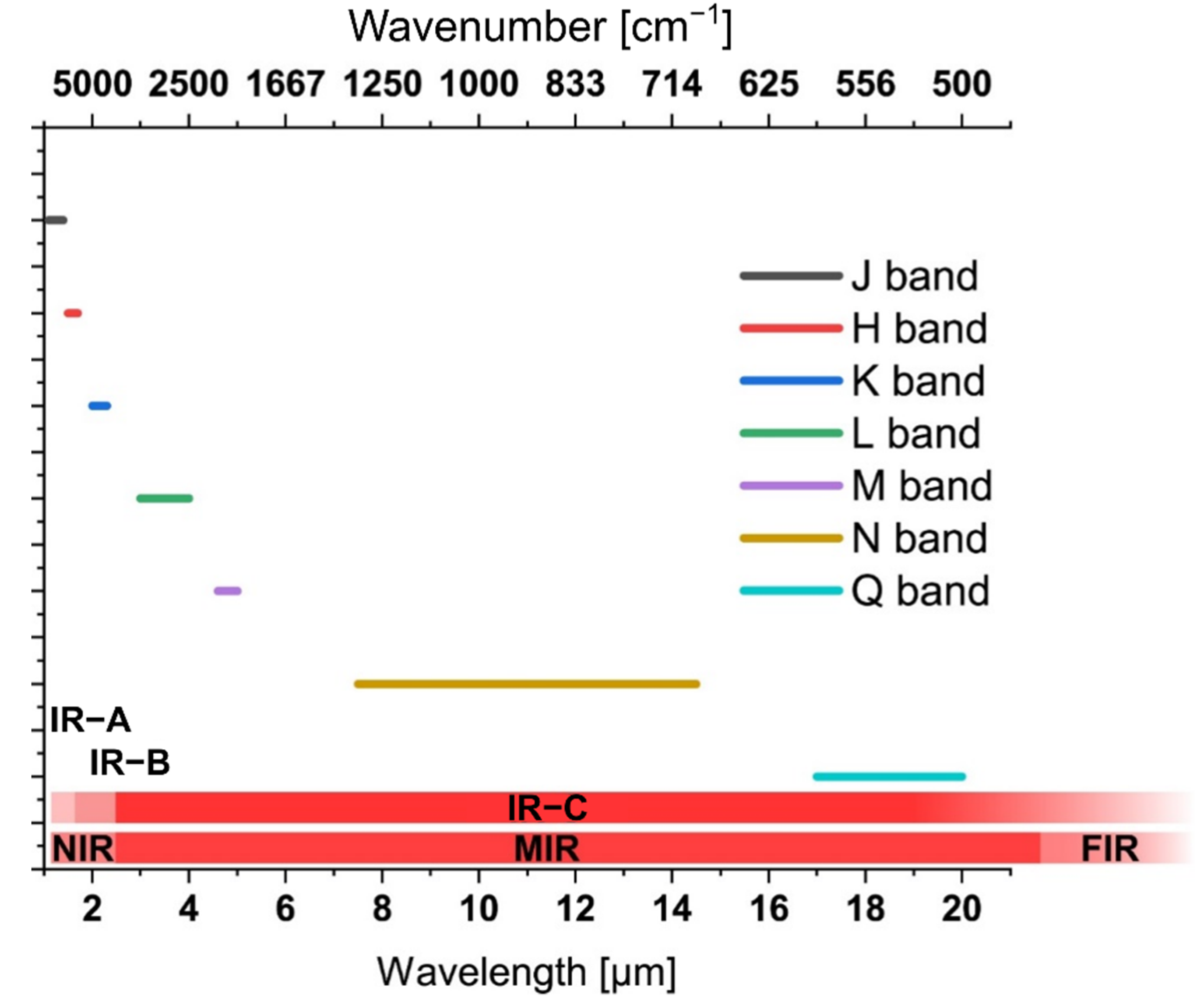
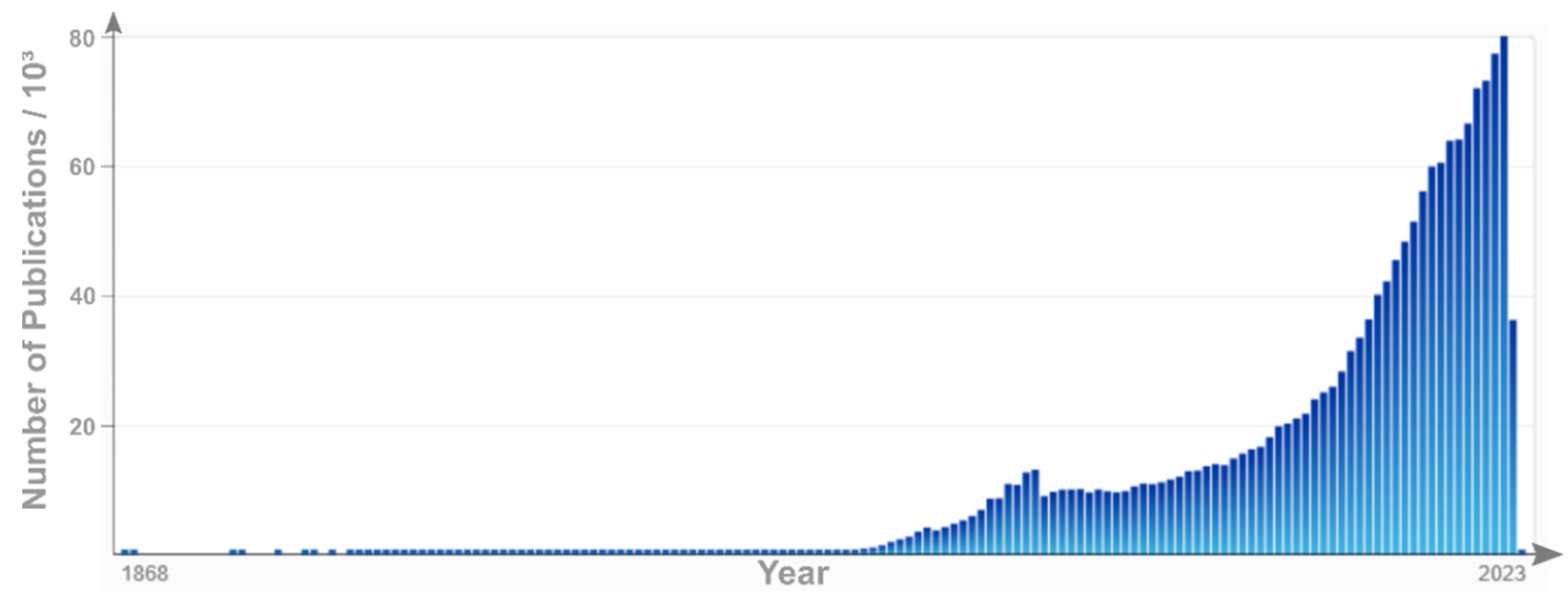

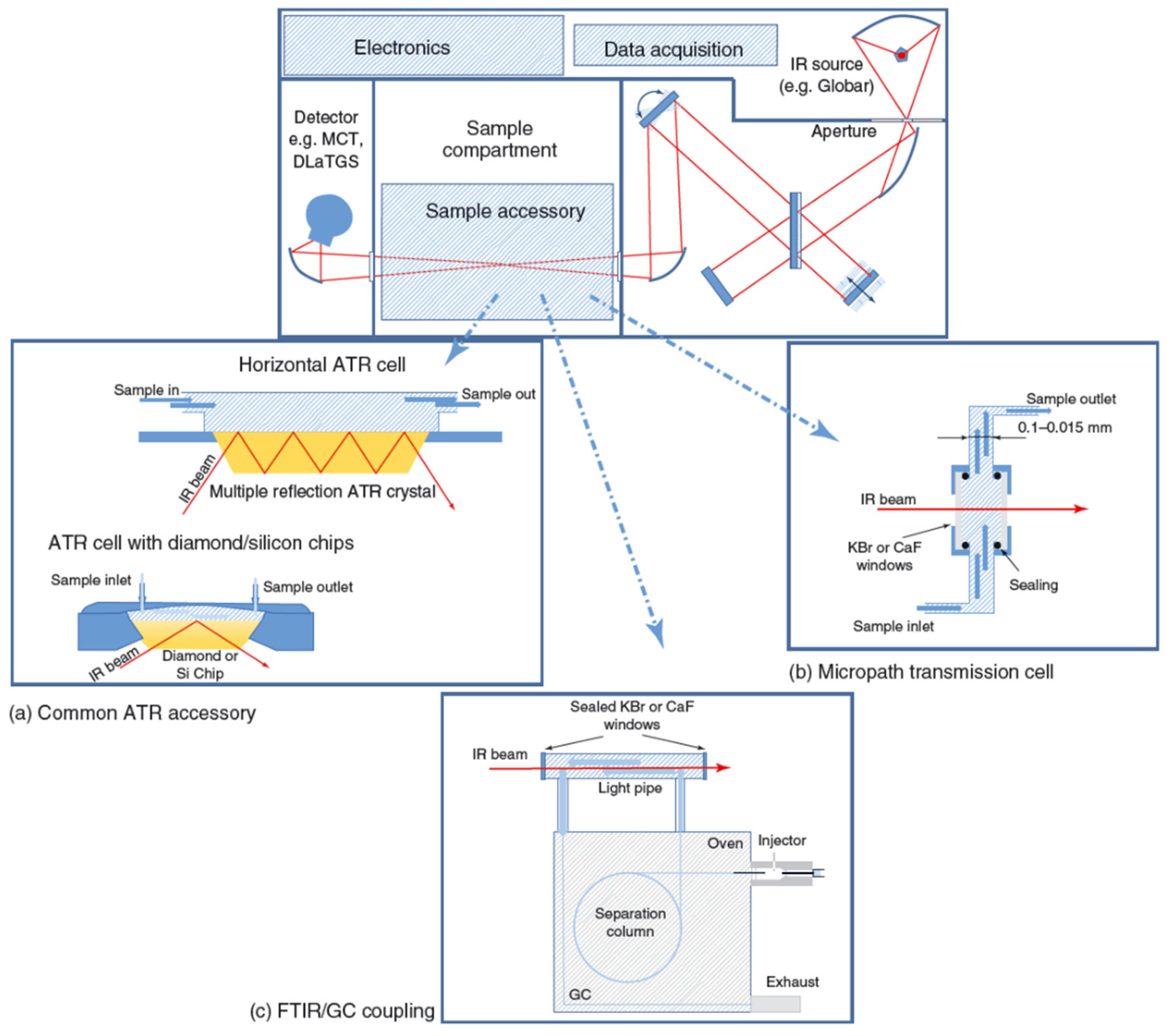
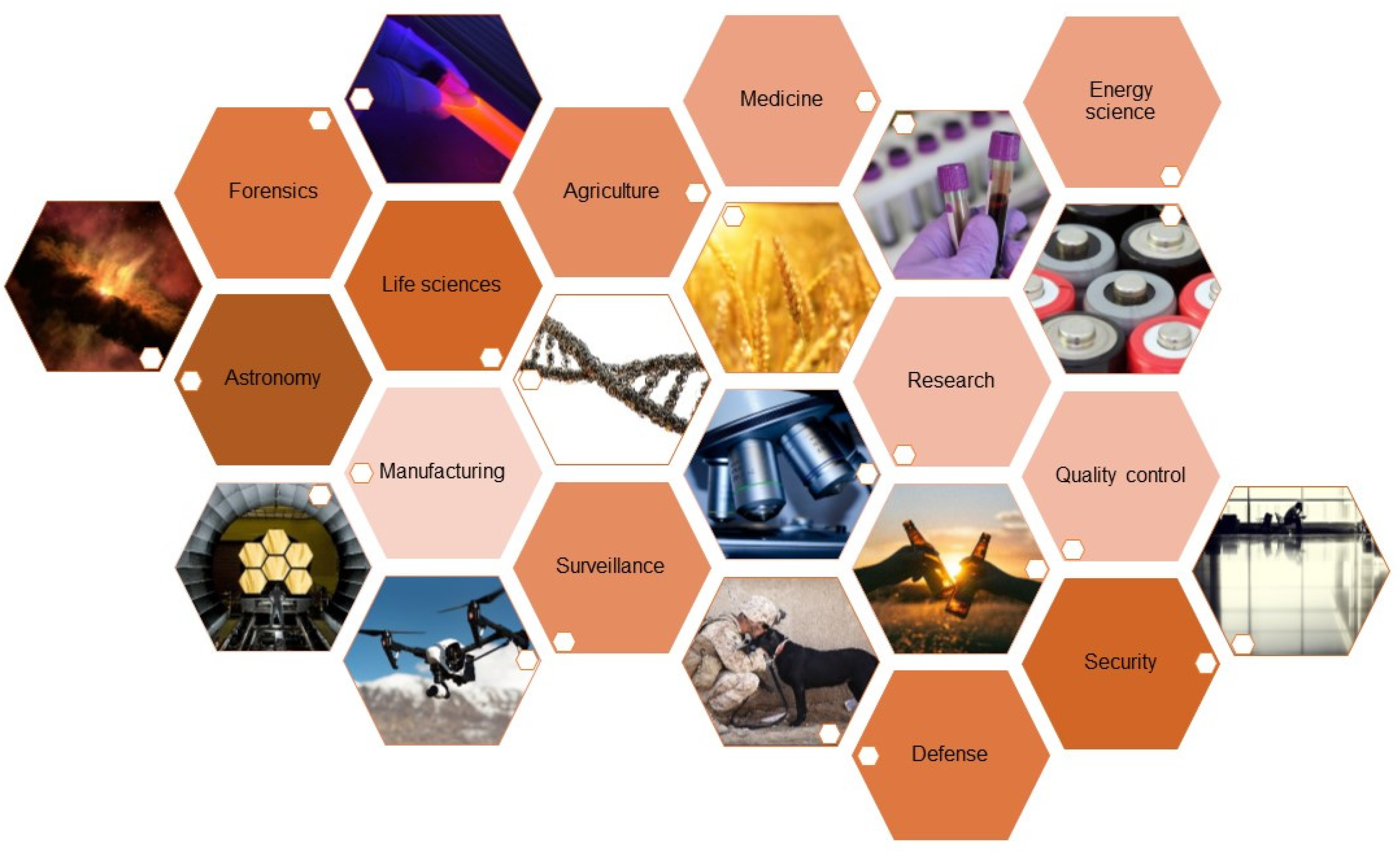
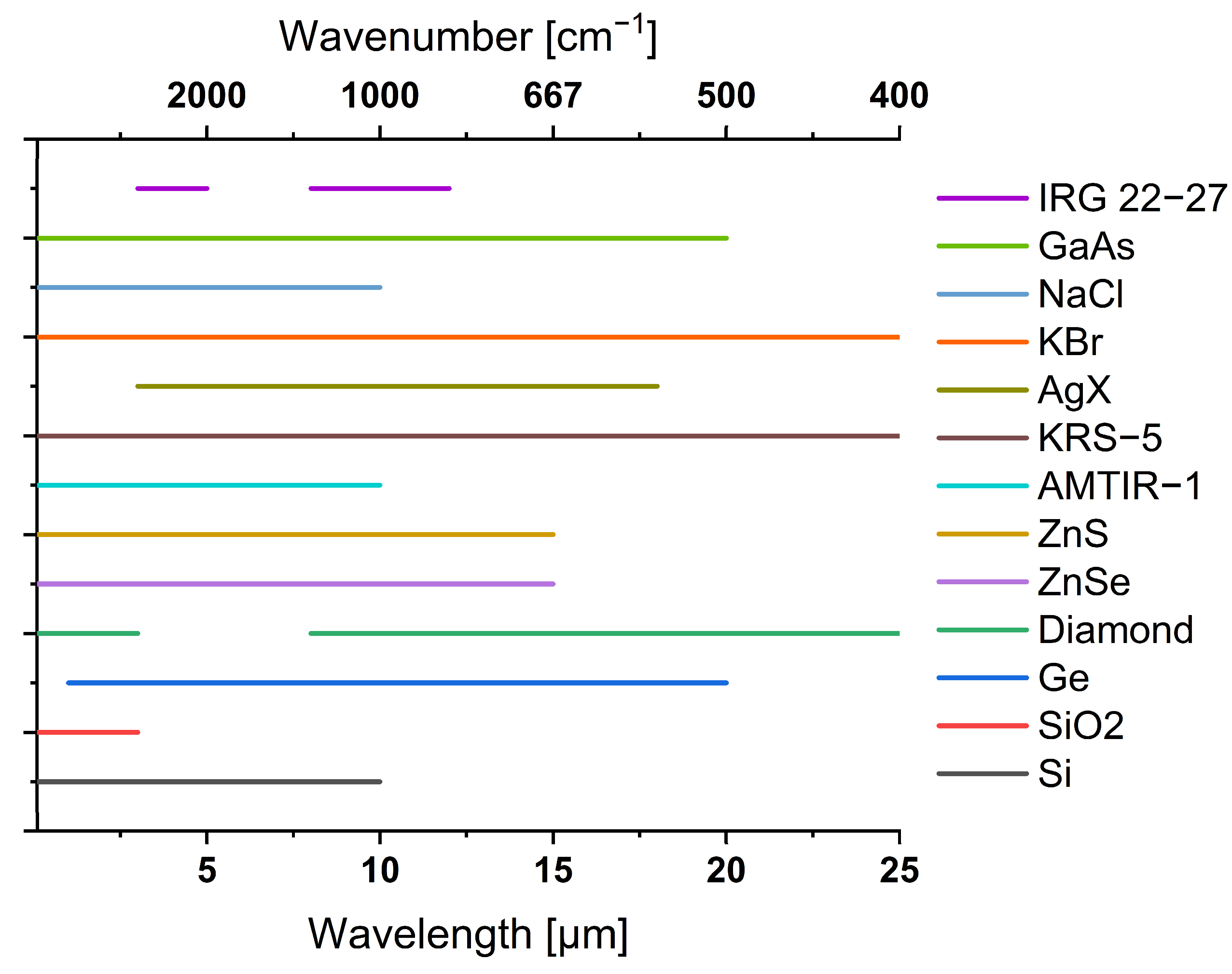
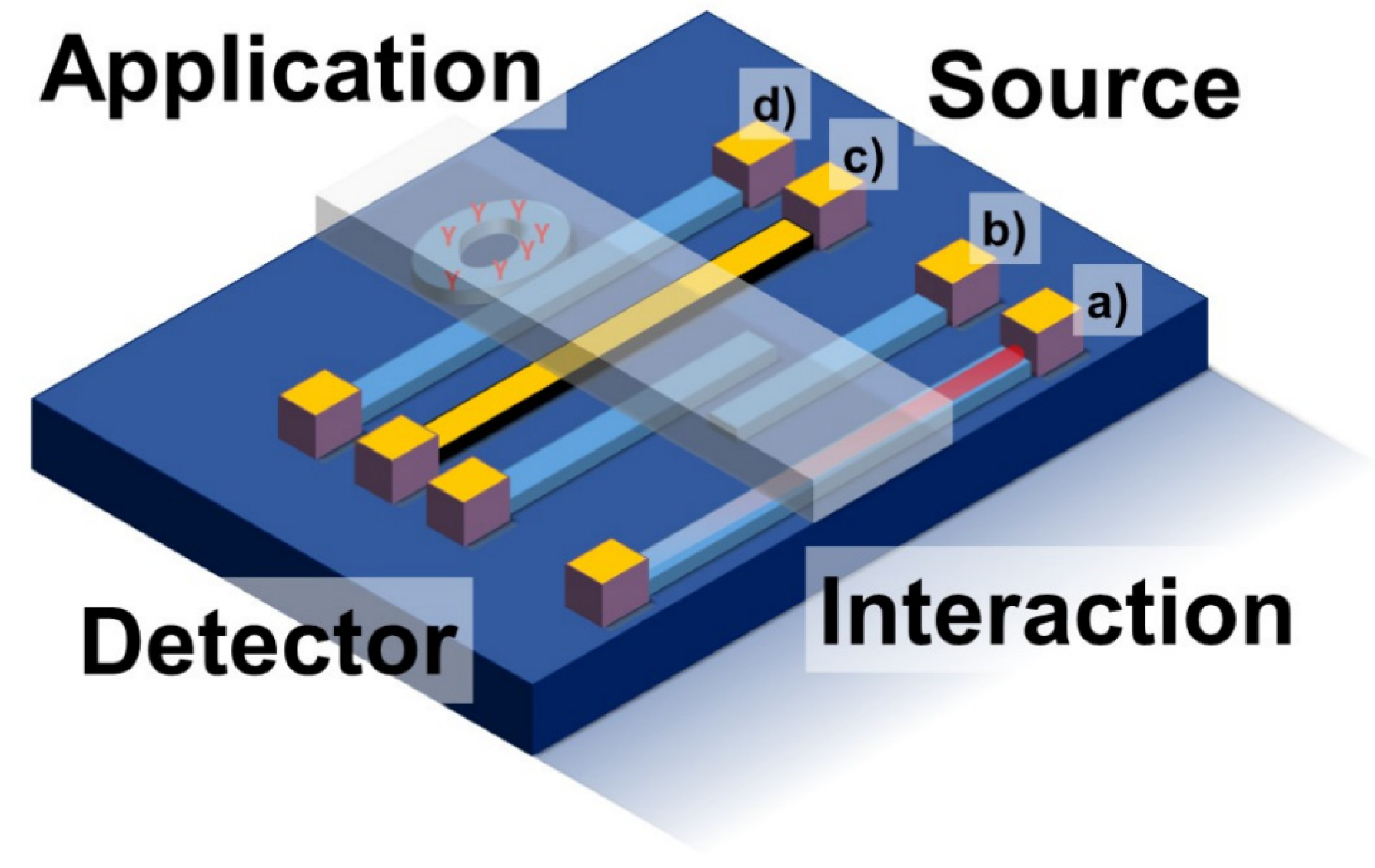
Publisher’s Note: MDPI stays neutral with regard to jurisdictional claims in published maps and institutional affiliations. |
© 2022 by the authors. Licensee MDPI, Basel, Switzerland. This article is an open access article distributed under the terms and conditions of the Creative Commons Attribution (CC BY) license (https://creativecommons.org/licenses/by/4.0/).
Share and Cite
Hlavatsch, M.; Haas, J.; Stach, R.; Kokoric, V.; Teuber, A.; Dinc, M.; Mizaikoff, B. Infrared Spectroscopy–Quo Vadis? Appl. Sci. 2022, 12, 7598. https://doi.org/10.3390/app12157598
Hlavatsch M, Haas J, Stach R, Kokoric V, Teuber A, Dinc M, Mizaikoff B. Infrared Spectroscopy–Quo Vadis? Applied Sciences. 2022; 12(15):7598. https://doi.org/10.3390/app12157598
Chicago/Turabian StyleHlavatsch, Michael, Julian Haas, Robert Stach, Vjekoslav Kokoric, Andrea Teuber, Mehmet Dinc, and Boris Mizaikoff. 2022. "Infrared Spectroscopy–Quo Vadis?" Applied Sciences 12, no. 15: 7598. https://doi.org/10.3390/app12157598
APA StyleHlavatsch, M., Haas, J., Stach, R., Kokoric, V., Teuber, A., Dinc, M., & Mizaikoff, B. (2022). Infrared Spectroscopy–Quo Vadis? Applied Sciences, 12(15), 7598. https://doi.org/10.3390/app12157598





